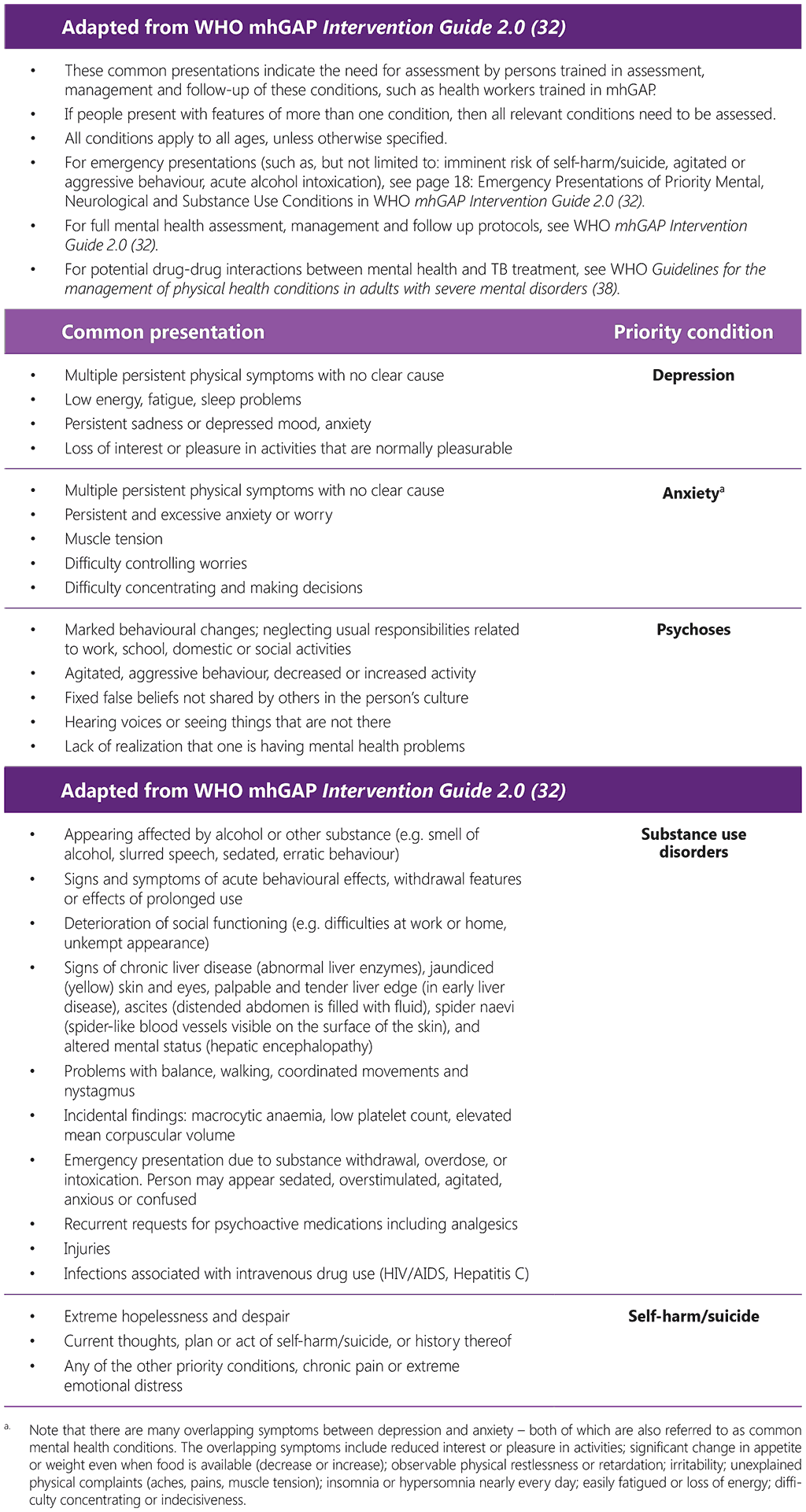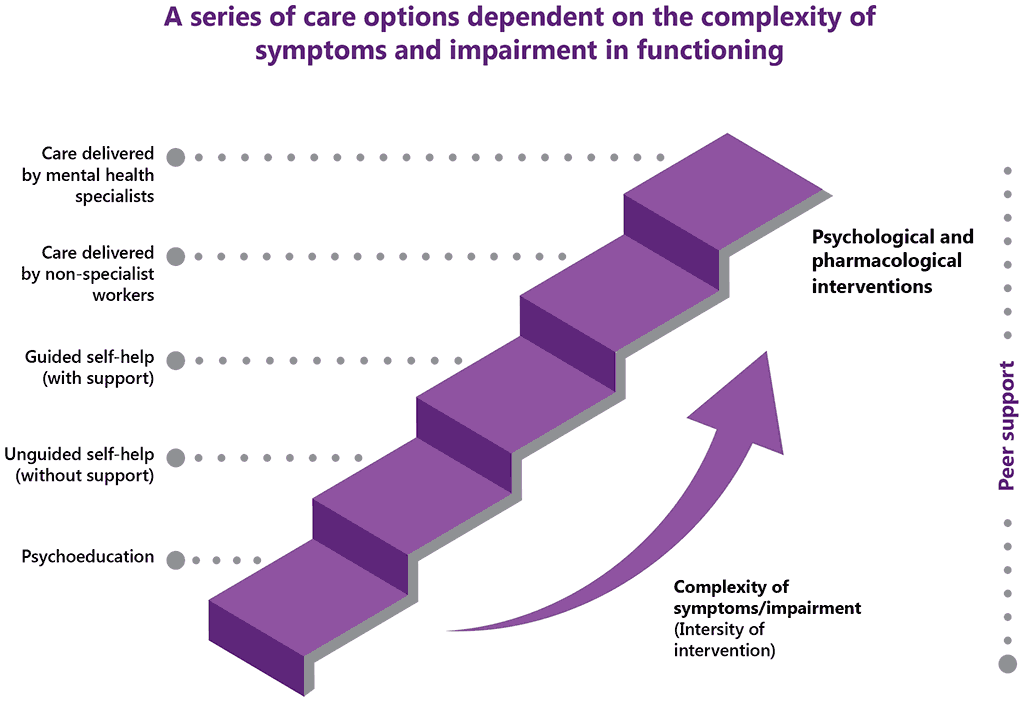كتاب روابط اجتياز لـ 1266
Mental health care is one of the health services to be integrated with TB services as outlined in the End TB Strategy and the WHO Framework for collaborative action on tuberculosis and comorbidities (2, 30). Within healthcare services, this integration includes identifying people with TB who are experiencing comorbid mental health or substance use conditions, and upon identification, managing the needs of the person – which can be achieved through referral to existing mental health or substance use services, or through task shifting to primary care health workers who have been trained in the assessment and management of mental disorders.
Key mental health conditions affecting individuals with TB are depression, anxiety, psychosis, substance use disorders and suicidal behaviours. TB diagnosis, illness course, treatment and/or stigma and discrimination, inflate the likelihood of each of these. Table 1 shows the common presentations of these conditions, and that many symptoms of mental health conditions overlap with those of TB or the side effects of TB treatment. The annex lists WHO guidance available to address these conditions.
Ideally, everyone with TB should be assessed for the above-mentioned mental health conditions or substance use disorders prior to or upon initiating treatment for TB, and at routine assessments. However, the availability of services for mental health and substance use in most countries remains largely inadequate – in some countries the treatment gap for severe mental health conditions is up to 90% (11). For this reason, opportunistic identification may be a prudent use of existing resources: health workers can initiate identification when a person accessing TB care appears with signs of the common presentations of mental disorders (see Table 1). Identification can be achieved through use of screening tools for mental health and substance use.
Several standardized instruments (discussed in more detail within this guidance) are available in many languages, are easy and fast to administer, and have been widely used across diverse settings (see Table 1). As screening instruments offer information on the severity of a person’s symptoms, rather than whether or not they meet diagnostic status, they can be used to identify people in need of further assessment (by a person trained in assessment of mental disorders) and/or detect changes in symptoms over time. Additionally, people at the end of anti-TB treatment may also be assessed for mental health conditions or substance use disorders. If mental health conditions or substance use disorders are present, linking people to mental health care may be important to prevent loss to follow-up during treatment, or to continue care after being discharged from the TB programme.
Ensuring TB services have referral pathways to available mental health services is an essential aspect of integrating services. Yet, task-sharing with primary healthcare providers has been shown to help reduce the treatment gap and increase coverage for priority mental health conditions. WHO has developed a series of guidelines and materials to inform the management of mental disorders in non-specialized primary care settings (31-34). Under the WHO Mental Health Gap Action Programme (mhGAP), the WHO mhGAP Intervention Guide for mental, neurological and substance use disorders (32) provides evidence-based guidance and capacity building tools for health professionals and settings not specialized in providing mental health care. Non-specialist health workers (such as those serving TB populations) can be trained in the identification, assessment, management and follow-up of priority mental health conditions. Table 1 presents an overview of priority mental health conditions and their common presentations. Additional guidance is also available for specific conditions or situations, such as the WHO/UNODC International Standards for the Treatment of Drug Use Disorders (35), WHO Guidelines for identification and management of substance use and substance use disorders in pregnancy (36), and the WHO guidelines on Community management of opioid overdose (37).
Table 1. Overview of priority mental health conditions

Models of delivery such as collaborative care (39) are also a promising approach for providing integrated evidence-based, person-centred care for mental health in physical healthcare settings. Collaborative care employs systematic identification of affected people, close monitoring of individual outcomes, treatment by care managers who may be trained to deliver brief educational, psychological and social interventions, and organized caseload consultations with mental health specialists, where available. Similarly, the 2022 Framework for collaborative action on tuberculosis and comorbidities provides guidance on how to develop and scale up collaborative action on TB and comorbidities, complementing the clinical aspects considered in this guidance (2).
At the systems level, and echoing the guidance outlined within the WHO Framework for collaborative action, the WHO implementation guidance on Integrating the prevention and control of noncommunicable diseases in HIV/AIDS, tuberculosis and sexual and reproductive health programmes to strengthen health systems (40), outlines action at multiple domain levels to benefit integration:
- people and community, e.g. people with lived experience of the health condition must be included in planning and design of services;
- policy and leadership, e.g. ensuring policies or legislation are in place to provide the mandate for integrated service delivery;
- financing, e.g. health financing should support and incentivize the delivery and use of integrated care;
- capacity and infrastructure, e.g. health workers have the necessary capacity and competencies to deliver integrated services; and
- models of delivering integrated care give due consideration to how services should be delivered, the processes of care, and how providers and management of services are organized.
Fig. 1. Continuum of options in mental health care

At the services level, establishing person-centred, integrated TB and mental health services involves several steps. First, is the identification of opportunities for mental health support options within the local geography serving the TB community. This can include opportunities to strengthen family support and community support through, for example, a religious organization. Other opportunities might include the delivery of psychoeducation by care providers, peer supporters, trained providers of brief psychological interventions, and available mental health specialists.
One key element of people-centred care is the tailoring of interventions to the needs of individuals. In mental health care, a continuum of options is available, depending on the complexity of symptoms and associated functional impairment, as illustrated in Fig. 1. Some individuals experiencing mental health symptoms will benefit from basic psychoeducation and self-help strategies. Others may require additional support such as brief psychological interventions, which can be delivered by trained and supervised non-specialist workers. Others may require the support of mental health specialists who deliver psychological interventions and/or pharmacological care and in the rarest circumstance they are needed, acute-care options should be available.
Next, it is necessary to strengthen linkages between the existing mental health support options and services to ensure close coordination of care. Further, TB services must establish clear protocols for identification and management of people with mental health conditions by employing screening tools, for example, or building the capacity of TB health workers to assess and manage mental disorders through WHO mhGAP (32). Referral pathways can also be established with existing mental health support systems and services. Finally, robust monitoring and evaluation are needed for ongoing quality improvement.

 تعليق
تعليق